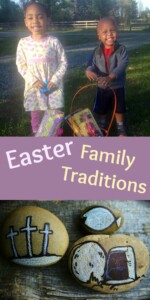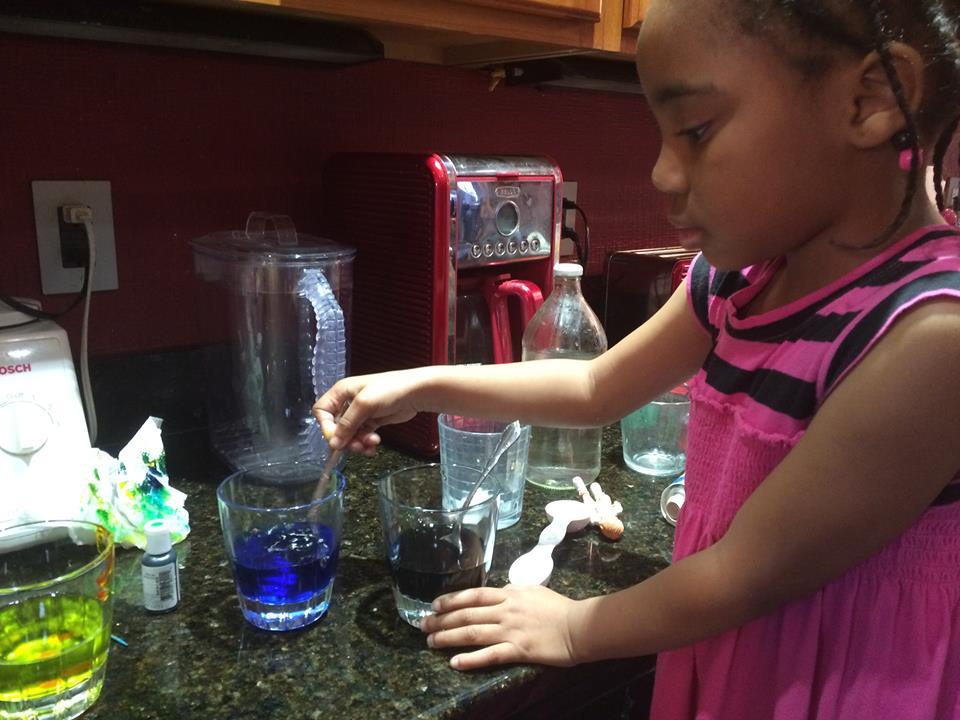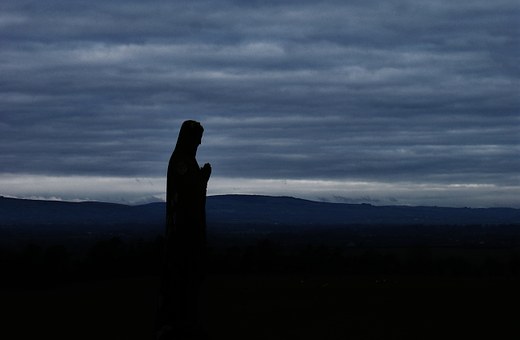Easter Family Traditions
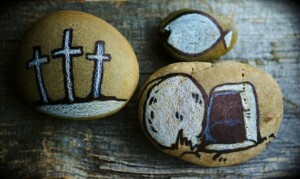
The best reason for traditions
The Easter story is the greatest story ever told, and the empty tomb the greatest symbol! Its emptiness reminds us that the One we worship is no longer dead. There is no grave to visit and no monument because He rose after three days of darkness and is alive. What greater cause for celebration can there be for the Christian?!
How should we celebrate Easter? Better yet, what can we do to help our children understand its importance and the true significance of that empty tomb?
Easter Traditions
Here are some celebratory traditions and the meaning behind them for the Easter season. Perhaps they will give you some pause as you consider how to celebrate the true joy of this Easter season with your family!
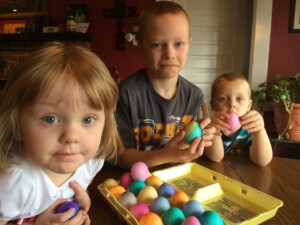 Coloring Easter Eggs.
Coloring Easter Eggs.
The Easter egg is symbolic of the resurrection of Jesus Christ. Some churches have a tradition of dyeing eggs red to represent the blood of Jesus. The egg is an ancient symbol of new life, and represents Jesus’ leaving the tomb. Sadly, many of us do not explain the reason for this symbol (or might not even know the reason ourselves). I never considered why we dyed Easter eggs; it was just something we did. If I could go back, I would use the opportunity to talk to my kids about the “why” of this tradition as we dyed our eggs around the kitchen table.
Easter Baskets.
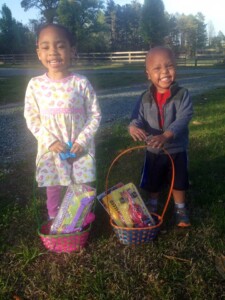
An Easter basket is full of candy, small gifts, or other items. At my school, students brought their own baskets which were then filled by the teachers with candy. Older students “hid” the baskets of younger grades in their classrooms. On a signal, the students returned to their classroom to search for their hidden basket. Our family tradition on this one varied, but the baskets had practical items instead of just candy (toothbrushes, toothpaste, etc.). Dave had fun hiding the baskets outside – up in trees, inside well houses, under or on top of outdoor furniture, and any place a child never thought to look. The basket can also be a symbol of the Gift of life through Jesus and an expression of love and appreciation to the recipient.
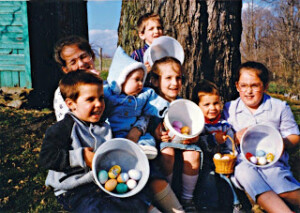
Easter Egg Hunts.
Children enjoy searching for – and finding – colored eggs hidden in the house or outside. These eggs can be the ones they helped color themselves. When the women went to the tomb on Easter morning, they found a stone rolled away and a missing body. That’s because Jesus had risen! Spring is a season of finding new life and new growth, just as we search for and find hidden Easter eggs.
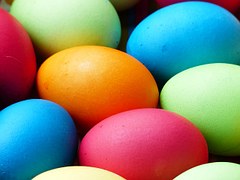 Easter Egg Rolls
Easter Egg Rolls
The school I attended also had an annual Easter Egg Roll. Each student brought his decorated (hard-boiled, sometimes waxed) egg. We climbed the hill next to the school and divided up by grades. At the signal, each grade took turns rolling the eggs down the hill. The egg that went the farthest from rolling down the hill without a crack was the winner. I don’t know the meaning behind this tradition, but since this public school was particularly for Anabaptist students, the exercise allowed for a physical activity outside along with competition, all using an Easter symbol for the season. Some folks say that the egg roll is symbolic of the stone being rolled away from the tomb. Perhaps, for those of us who participate in this tradition, we would do well to explain the reason behind the tradition.
 Easter Sunrise Service
Easter Sunrise Service
This service is held at sunrise to symbolize the resurrection of Jesus. When the women came to the tomb, it was early morning and we assume it was close to sunrise. To their amazement, they found the stone rolled away. If you have opportunity to participate in one of these, you will enjoy watching the sun rise as the service progresses. We gather in darkness and leave in the light, also a symbol of life in Christ and the hope of the resurrection.
Family Devotions
Use your family devotions as a time to explain the meaning behind Easter. 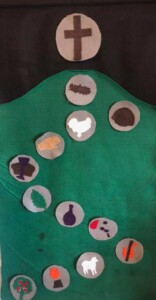 Our family did a “Road to Calvary” banner each year. Beginning in Genesis, we read about the world God created and how sin entered the world. Each day’s reading took us to another place in scripture: Noah’s ark, Abraham’s sacrifice, the serpent on the pole, and the Passover Lamb. The road continues into the New Testament, and includes Gethsemane, the crown of thorns, and the cross. By the end of these readings, the road to Calvary is complete. The next morning, the first child downstairs got to flip the banner over where the words “He is Risen!” proclaims truth. Guaranteed, it was one way to help children get up on Easter morning. Every child wanted to be the first one downstairs to turn over the banner.
Our family did a “Road to Calvary” banner each year. Beginning in Genesis, we read about the world God created and how sin entered the world. Each day’s reading took us to another place in scripture: Noah’s ark, Abraham’s sacrifice, the serpent on the pole, and the Passover Lamb. The road continues into the New Testament, and includes Gethsemane, the crown of thorns, and the cross. By the end of these readings, the road to Calvary is complete. The next morning, the first child downstairs got to flip the banner over where the words “He is Risen!” proclaims truth. Guaranteed, it was one way to help children get up on Easter morning. Every child wanted to be the first one downstairs to turn over the banner.
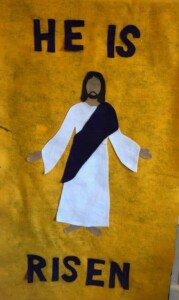
Using a method like this helps our children understand how the human family got from the beautiful, sinless Garden of Eden to the painful, tearful garden of Gethsemane and then the cross. The idea for this banner, the pattern with directions, and the readings come from the book Family Celebrations –Meeting Christ in Your Holidays and Special Occasions by Ann Hibbard. The author encourages you to start many weeks before Easter, doing just doing one symbol each week. We did ours nightly (or almost) in our family devotions. I asked my sister to make the banner and the symbols for us since I am not that artistic. Our banner is over twenty-five years old, and it is still used today in different settings.
This book can be purchased through Amazon.
Five-Egg Story
When our children were in public school, I did a story hour several times a year in their classrooms. Near Easter time, I told the Easter story through five plastic eggs. You can make your own story lines, as it is quite simple to do. Adjust it for the children you are teaching and for their reading level. You can have them read parts of the story or just read it to them. Have the symbol inside each designated egg before you begin. As you tell (or have a child read) each two or three sentence story, you allow one child to open the egg that corresponds with the story.
#1: In the beginning, the world and the garden God created was beautiful. There was no sin.” Symbol: a pretty flower.
#2: Then one day, Satan came to the man and the woman. They listened to Satan and disobeyed God. That is why there is sin in the world. Now the world was not pretty anymore. Symbol: dirty soil.
#3: God had a plan to save the people from their sins. He sent His son Jesus to teach people how to do what was right. Some bad people got mad at Him and wanted to kill Him. Jesus had to die on the cross for the sins of everybody. Symbol: a small cross, thorns, or “bloody” cloth
#4: After Jesus died, the disciples buried Him in a tomb. The soldiers put a big stone in front of the tomb so no one could get in – and so Jesus could not get out. On Easter morning, what do you think they found inside the tomb? Symbol: empty egg [I always loved watching the amazement on the faces of children to find an empty egg!]
#5: Forty days after Jesus came back to life, He went to Heaven. He went to get a place ready for us to live with Him after we die. That place is Heaven. Do you know why He came to the earth? Symbol: Words “You and Me” OR a small mirror or piece of foil where the child can see himself.
Resurrection Eggs
This is a set of 12 plastic eggs, each containing a symbol telling the story of Easter. I’ve used this set at home and at church. The children love reading the scripture and then opening the egg that corresponds with the scripture. The scriptures and symbols are nearly the same as the ones in the Road to Calvary Banner and can be purchased online through various sources, including Amazon.
Traditions are an opportunity for teaching!
What a wonderful opportunity to teach our children the message of salvation as well as the importance of living the Resurrection daily! Choose your celebrations based on truth, and help your children understand the significance of the empty tomb. It will make all the difference in their world!
